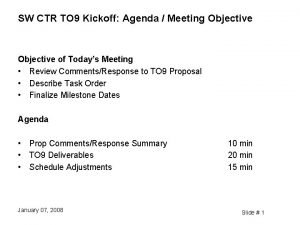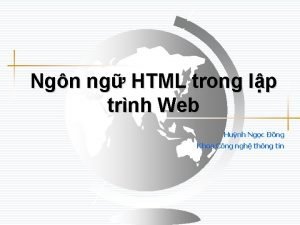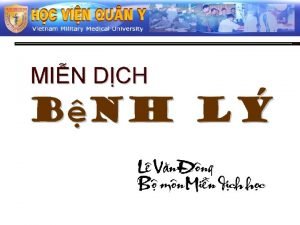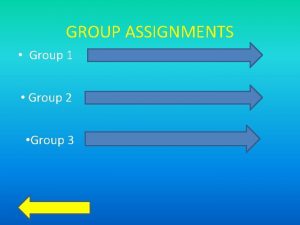10 th meeting of the Washington Group on












- Slides: 12

10 th meeting of the Washington Group on Disability Statistics Recent developments on disability statistics in the European Union Lucian AGAFITEI Eurostat Unit F 5 “Health and food safety; Crime”

Policy context n European Disability Action Plan (2003 -2010) need to develop consistent statistics of disabled people in the enlarged European Union n UN Convention on the Rights of Persons with Disabilities obligations for the Member States and the EU (Articles 31, 33 and 35): – to monitor and regularly report on its implementation – to collect statistical information on disability need to produce information on disability defined in accordance with the UN Convention and the ICF 2

Existing European health surveys/modules - incl. disability – EU-SILC: annual survey • Minimum European Health Module (MEHM) + unmet needs of medical and dental care Healthy life years (HLY) + dissemination on website – EHIS (2007 -09): every 5 years • good harmonisation (same questions, translation protocol, 18 MS involved, etc. ), about 130 questions – Disability: • LFS ad-hoc module 2002 and 2011 on the “employment of disabled people” 3

EU-Statistics on Income & Living Conditions, SILC n Global Activity Limitations Indicator (GALI) question (The GALI is part of the Minimum European Health Module, MEHM): n Two other single-question items on selfperceived health and chronic conditions 4

European Health Interview Survey, EHIS n First round (2007 -2009): implementation in about 21 European countries (18 Member States) n 4 modules: EHSM, EHCM, EHDM and EBV n EHSM includes, inter alia, questions on difficulties in: – basic activities (seeing, hearing, walking, stretching, etc. ) – more complex activities: • ADL (personal care) • IADL (household care) n Next round: 2014 with an EU legal basis 5

Use of the Budapest Initiative questions in EHIS 2014 n Conclusions of the Berlin workshop (30/09 -01/10/2010): – it was agreed that BI questions would be considered for: • Replacing existing EHIS question PL. 5 (hear in conversation) with BI Hear_3 and Hear_4 (context of hearing a conversation) • Specifying the length 500 m in the EHIS question PL. 6 (like in BI MOB_5) • Including a question about walking difficulties (100 m) • Pain and mental well-being 6

Labour Force Survey (LFS) ad hoc module on employment of disabled people n Aim: to provide information on the situation on the labour market of disabled people and to compare it with the one of non disabled people n Content (2011): – Health problems and difficulties in basic activities – Limitations in work caused by health problems/difficulties in basic activities – Special assistance needed or used by people with health problems/difficulties in basic activities – Limitations in work because of other reasons Seminar on April Disability, 19 - 20 2010 Rome 7

New developments: From European disability and social integration module (EDSIM) to European survey on health and social integration (ESHSI) n Aim: to develop a module on participation of people with disabilities in society life n Development followed the EHIS adoption n Originally, planned as an EHIS module n First version produced end of June 2008 n Pilots in 10 MS on translating and cognitive testing in 2009 n Updated version October 2010 n Implementation in 2012 in all Member States 8

EDSIM/ESHSI Design of the module: challenge and solutions (1) n Use of ICF classification to design a questionnaire – Focus on the key aspects of social integration based on policy needs and use the ICF as a reference text rather than a driver of content – Translate the language of the ICF to common terms used in national surveys – Try to have a coherent rather than a comprehensive set of questions 9

EDSIM Design of the module: challenge and solutions (2) n Designing variables/questions which reflect the interactive nature of the current definition of disability – Start off not asking about personal factors (health or impairments) but asking about participation/limitation in daily activities • Learning opportunities, work, social activities • Mobility, transport and accessibility to buildings – For those not participating or with limited participation identify the barriers • Personal (health conditions, impairments) • Environmental factors (finances, convenience, lack of assistive devices or personal help) 10

EDSIM: content of questionnaire (based on ICF) n 12 SECTIONS : – Socio-economic background – General health and longstanding health problems – Mobility – Transport – Accessibility to buildings – Education and training – Employment – Internet use – Social contact and support – Leisure pursuits – Economic life – Attitudes and Behaviour 11

Strategy for EU surveys with disability information n Task Force on Disability Statistics (TFDS) – Set up in 2010; it met 2 times (in January and June) – Experts from BE, DK, ES, FR, SI, IT, NL, RO, UK, incl. representatives of disability organisations n European Commission and TFDS support the idea of conducting every 5 years an independent disability survey (ESHSI): 2012, 2017, 2022… n EHIS would be conducted in 2014, 2019, 2024… 3 -5 November 2010 12























